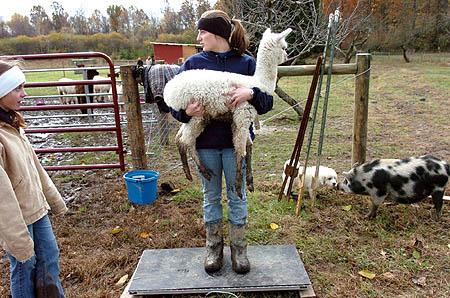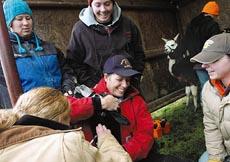
Lake Fong, Post-Gazette photos
Veterinary student Jessica Horowitz, 19, holds Fredrick, a 21-day-old alpaca for weight measure at Hog Heaven Rescue Farm as Kayla Shreves, 13, of Andover, Ohio, watches.
Wednesday, November 08, 2006

Lake Fong, Post-Gazette photos
Veterinary student Jessica Horowitz, 19, holds Fredrick, a 21-day-old alpaca for weight measure at Hog Heaven Rescue Farm as Kayla Shreves, 13, of Andover, Ohio, watches.
By Linda Wilson Fuoco
Pittsburgh Post-Gazette
Nine students listened attentively as their instructor talked about the breeding cycles of chickens, turkeys, ducks and peacocks. The lecture was not disrupted at all when loud, indignant squeals erupted outside, followed by pushing and pounding that made the classroom door rattle and vibrate.
"Oh, that's just Oscar and Skinny. They want to come in. They're class mascots, and they're usually allowed in here but not on cat neutering day," said Regina Martin.
Oscar and Skinny are Vietnamese potbellied pigs, and their presence in and out of the classroom is normal, for this classroom is in the heart of the Hog Heaven Rescue Farm Inc. in Cochranton, Crawford County. Ms. Martin and David Allman, both retired Pittsburgh police officers, have operated the farm for eight years.
The students and their instructor, veterinarian Erin Moore, ignore, for now, the squeals. They do keep an eye on 19 woozy cats and kittens that are waking up from anesthesia. Dr. Moore neutered the male felines, with the assistance of the students, who are training to be veterinary technicians.
The students are spending five days on the farm, one of their last "classes" before graduating from the 16-month program at the Vet Tech Institute, formerly the Median School of Allied Health Careers. Dr. Moore is the school's large animal instructor. Working with her is Tina Gilson, a certified vet tech instructor.
Students spend most of their time studying cats and dogs at the school, on 7th Street in Downtown Pittsburgh. Starting last July, the school and the rescue farm hooked up in a cooperative venture that benefits both sides -- hands-on experience for students and helping hands for the animals that arrived at the rescue farm when their owners were unwilling or unable to care for them.
The current Hog Heaven census includes 74 potbellied pigs, three goats, one Scottish Highlander cow, 13 alpacas and 42 equines -- horses, mules and donkeys.

Veterinary students Kayleigh Hill, 20, left, Ann Loucks, 19, and Stephanie Glenz, 21, watch instructor Tina Gilson draw blood from an alpaca. Another instructor, Dr. Erin Moore, holds the alpaca.
Life on the farm has been eye-opening, for so far all of the students have been from the city or the suburbs. Most have no experience with farm animals, although each class has had a student or two who has owned and ridden horses.
"We've gotten students who were absolutely terrified of horses," Mr. Allman said. "We start them out with older, gentle horses."
Veterinary students Kayleigh Hill, 20, left, Ann Loucks, 19, and Stephanie Glenz, 21, watch instructor Tina Gilson draw blood from an alpaca. Another instructor, Dr. Erin Moore, holds the alpaca.
Student Suzy Gruber of Elizabeth chuckled as she recalled her boyfriend's reaction when he helped her carry her bags into the living quarters. "He said, 'Hey, there are horses loose here.'"
Most of the animals are in barns and fenced pastures, but some have the run of the farm and like to hang out around the house and the classroom. One of those "loose" horses is a 7-month-old brown and white "paint" colt named Takoda, which means "friend to all " in Sioux. He follows the students -- and visitors -- around like a big dog.
"I know I definitely want to work with animals, but I hadn't thought about working with farm animals," Ms. Gruber said.
That could be an added benefit of this cooperative program, Mr. Allman said. Most students come with no intention of working with large animals, despite a growing shortage nationally of both rural veterinarians and support staff. That's partly because of the limited number of accredited veterinary colleges in the country -- 28 -- but also because rural vets work under more difficult conditions and longer hours than their urban counterparts who specialize on small animals.
After a week at Hog Heaven "three or four out of a class of eight or nine say they would consider working with large animals," he said.
Stephanie Glenz of Beaver already works part time for a veterinarian. Her family owns two horses, although she doesn't live on a farm. Her horses are boarded at a stable. She is very interested in working for a veterinarian who treats horses and other farm animals.
"It took me a while to find this program," she said. "I went to college for a while and I attended an art school."
Because the farm is 90 miles from Pittsburgh, the institute installed a modular home where students could stay overnight.
They sleep in bunk beds and while the students do cook, some of the most popular entrees are casseroles prepared by their moms. Most students are pretty tired after working all day outdoors and turn in early.
Dr. Moore takes students on field trips to nearby chicken and dairy farms.
One young woman acknowledged she had an irrational fear of birds. She was helped to overcome that fear, for holding a chicken was one of the course requirements.
And although this is a "large animal" class, the extra hands of the students have enabled Hog Heaven to branch out into a program aimed at stopping the population explosion of local cats.
In the past three months, 156 male cats -- primarily "barn cats" who live outdoors -- have been neutered and inoculated by Dr. Moore. The charge is $16, as opposed to the fee charged by private veterinarians, which would be $80 and up.
"We divide [the students] into groups," Ms. Martin said. "One group does paper work, including the rabies certification. A second group trims nails and checks their ears for mites. A third group does the shots and runs lines for anesthesia. The fourth group helps Dr. Moore with the surgery."
When the cats are taken from the classroom to be returned to their owners, Oscar and Skinny trot into the room, where they beg for bits of the students' lunches.
"Potbellied pigs are the throwaway pets of the '90s," Ms. Martin explained. They're supposed to weigh 60 to 80 pounds, as opposed to the hogs raised for pork and ham, which reach adult weights of 800 to 900 pounds. But due to overfeeding, they may weigh 100 to 200 pounds.
They can be housebroken and can live in houses. Oscar, who weighs 75 pounds, was a house pet, but his owner tired of him. "They can be a bit much for some people, and they do like to dig. They dig up yards and may dig out of fences," Ms. Martin said. "But a lady in New Jersey saw him on our Web site, and she may be adopting him."
Dozens of animals are adopted every year, and their adoption fees help support the farm. Others will live out their days at Hog Heaven.
The alpacas are not actually "rescues." Their fleece is harvested yearly, which currently is being made into socks and teddy bears to sell.
"We'd like Hog Heaven to be around after we are gone," Ms. Martin said. Hopefully enough fleece can be harvested to make sweaters and other items that can generate income for the rescue farm.
This class of students had an unexpectedly poignant stay on the farm in late October.
They arrived at Hog Heaven on a Monday, the same day that Red, a 19-year-old quarter horse, arrived from New York. Shortly after Red was settled into his new stall, it became apparent that he was not feeling well. Ms. Martin and Mr. Allman feared he might have colic.
Colic is an ailment known to all horse owners. Colic can range from a mild belly ache to a life-threatening situation. With treatment, many horses recover. Others do not, for colic is the leading cause of premature death in horses.
Hog Heaven called in its horse vet, who prescribed a treatment including careful monitoring by Ms. Martin, Mr. Allman and the students. As Red's condition worsened, the vet came back and the students got to see first-hand treatment, including a needle inserted into his neck to administer drugs.
Red's condition continued to deteriorate and he was euthanized, with the students present.
"You give him a hug and you cry and then you have to move on," Ms. Martin told the students, who fought back tears.
Students had many questions for Dr. Moore later that day.
Colic can be caused by stress, internal parasites such as worms, or from something the horse shouldn't have eaten. It can be caused by a tumor or blockage. In the worst cases, a section of the intestines twists, and the only hope of saving the horse is a high-risk, $6,000 operation at a veterinary school clinic, but no guarantee that the horse will survive.
"But often we just don't know why horses colic," Dr. Moore said.
She performed a necropsy, the animal equivalent of an autopsy. Students solemnly -- and respectfully -- watched.
Red's 42 feet of intestines were filled with gas and unhealthy amounts of fluids. Although Dr. Moore did not find a blockage or tumor, she said that Red had been much sicker than he seemed to be.
"So there really was no hope of saving him," one student said sadly.
"Oh, honey," Ms. Martin told her. "If there was any hope of saving him, we never would have euthanized him."
The students learned, first-hand, that death is part of life on the farm.
"One dies, another comes in," Mr. Allman said, obviously saddened, although he had seen it before.
--------------------------------------------------------------------------------
The Hog Heaven rescue Web site, www.hogheavenrescue.org, includes information about animals available for adoption, fund-raisers to benefit Hog Heaven and other ways to help the rescue operation.
The site also has a memorial page about animals that died on the farm or later with the people who adopted them.
You can learn more about the Vet Tech Institute, 125 Seventh St., Downtown, at www.medicalandnursing-training.com/vet-tech-institute.html.
(Linda Wilson Fuoco can be reached at lfuoco@post-gazette.com or 412-263-3064. )